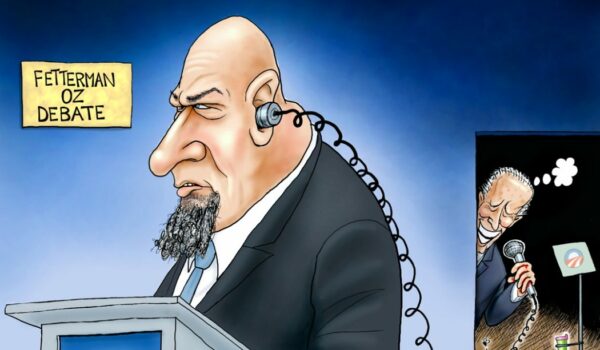
“House Speaker Nancy Pelosi’s husband, Paul Pelosi, was ‘violently assaulted’ early Friday morning by an assailant who broke into their home in San Francisco,” reports NBC News.
“Early this morning, an assailant broke into the Pelosi residence in San Francisco and violently assaulted Mr. Pelosi. The assailant is in custody and the motivation for the attack is under investigation,” said Pelosi’s office. “Mr. Pelosi was taken to the hospital, where he is receiving excellent medical care and is expected to make a full recovery,” said Pelosi spokesman Drew Hammill.
The man who attacked Paul Pelosi is reportedly a “former Castro nudist protester.” “Sen. Rand Paul (R-KY) denounced the attack, and wished Paul Pelosi well while also noting that when he was attacked, Christine Pelosi, the daughter of Paul and Nancy Pelosi, tweeted ‘Rand Paul’s neighbor was right.'” The attacker has also shared QAnon and right-wing conspiracy theories.
Ironically, if Pelosi had her way, more violent criminals would be released and in a position to attack innocent people like her husband. Pelosi backed legislation that would have released most federal inmates in certain age categories, or with certain health conditions (including temporary or treatable ones). Those prisoners would have been released, even if they had previously committed serious crimes such as murder, rape, and robbery.
That legislation, which passed the House but not the Senate, included provisions that would have released prison inmates because they are over age 50 or under 18. They could be released even if they had recently committed murder, and had served almost none of their sentence. These provisions were found in the so-called “Emergency Community Supervision Act.” It would have required the “Bureau of Prisons” to “place in community supervision” — supervised release — all prisoners who are “50 years of age or older,” or below age 18. (It also would have required the release of prisoners with less than a year left on their sentence, and inmates with a “health condition,” such as pregnancy, diabetes, “minor skin cancers,” or a weakened immune system.)
So if a 50-year-old murderer had just been put in prison, after being sentenced to 20 years, he could be released. It wouldn’t matter that he hadn’t served any of his sentence. Releasing such inmates is risky, since murderers can go on to kill again even when they are over 50. Famous serial killers were still active at age 50: Albert Fish started killing at age 54, and Dorothea Puente started at age 53. Peter Tobin kept killing until he was 60, and John Reginald Christie killed people until he was 53.
In theory, the bill allowed some dangerous prisoners to remain jailed, if prison authorities ask the courts to keep them in prison, and a court found strong proof that a prisoner poses a “specific” rather than generalized risk of violence. But it is hard to predict a specific violent crime even when the risk of violence is real. Criminals aren’t that predictable. They often commit different crimes after being released than they did in the past. Most murderers never kill again, but some do.
The bill didn’t allow inmates to be kept in jail just because it is slightly more likely than not that they will commit more acts of violence. To keep a dangerous inmate from being released, a judge would have had to find “by clear and convincing evidence” that the inmate poses “a specific and substantial risk of causing bodily injury to or using violent force against the person of another.” Even if a judge found such a risk, he could still have released an inmate after taking into account the inmate’s “age” and whether detention will affect “access to adequate medical treatment.”
Thus, the bill would have made it very hard to keep murderers in jail, especially murderers over the age of 50. That’s bad, because even elderly inmates can kill again. A transgender murderer was arrested for killing again at age 83, after two prior murder convictions. And Albert Flick killed a woman when he was 76, stabbing her at least 11 times while her children watched. He had previously been imprisoned for killing his wife by stabbing her 14 times in front of her daughter. After his first murder, he assaulted a woman in 2010, but he avoided a long prison sentence for that, because a judge deemed him too old to be a continuing threat.
It was a bad idea for the bill to let many inmates out of prison, because studies show that keeping inmates in prison reduces the crime rate. Parolees often commit more crimes after being released. Keeping inmates in prison longer deters crimes from being committed in the first place. Letting inmates out earlier results in more crimes being committed. This February, the U.S. Sentencing Commission issued a 116-page report titled “Recidivism of Federal Violent Offenders Released in 2010.” Over an eight-year period, violent offenders returned to crime at a 63.8% rate. The median time to rearrest was 16 months for these violent offenders. Thus, most violent offenders released from prison committed more crimes. Even among offenders over age 60, 25.1% of violent offenders were rearrested.
Pelosi may have felt that juvenile offenders deserved a second chance. But reducing or eliminating penalties for juvenile offenders, such as killers, increases the violent crime rate. As Peter Moskos notes, “Recidivism among 16-year-olds went up” a lot when the age for being prosecuted in adult court was raised in New York, including for violent crimes. Carjackings by teens are already skyrocketing, as fewer teens get prosecuted in adult court or sent to prison. Many violent crimes are committed by minors: Over 5% of murderers whose ages are known to the FBI killed before age 18.



